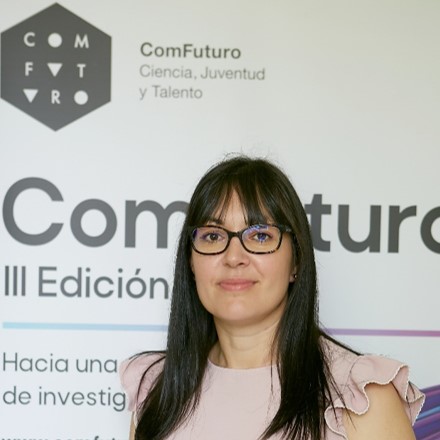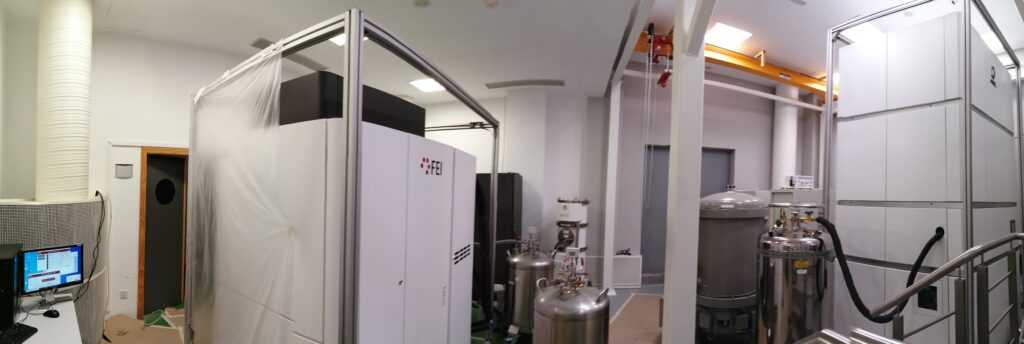
Olivia Muriel López holds a degree in Biology from the University of Málaga and a PhD in Biochemistry, Molecular Biology and Biomedicine from the Autonomous University of Madrid. After obtaining her PhD, she completed her postdoctoral training at the Universities of Geneva, supported by a long-term EMBO fellowship, and Lausanne.
Her career has focused on the study of membrane trafficking in various cellular processes, including adhesion to the extracellular matrix and cell fusion during sexual reproduction. Her trajectory has an important technological component, having implemented several cutting-edge microscopy techniques such as correlative light and electron microscopy and cryo-electron tomography.
Since April 2023, Olivia has joined the Centro Nacional de Biotecnología (CNB, CSIC), as a ComFuturo fellow, where she develops her project CRYOINNGENIC.

State-of-the art cryoelectron microscopy. An image of the two transmission cryo-electron microscopes recently installed at the CNB. On the left a 200 kV TALOS Arctica cryo-microscope, equipped with a Falcon III direct electron detector. On the right a 300 kV JEOL cryoARM cryo-microscope, equipped with a Gatan K3 direct electron detector and an Omega energy filter. This equipment is necessary to obtain structural information in situ and native conditions, main objective of the project.

Extended project summary:
The CRYOINNGENIC project aims to contribute to the field of innate immunity, and its use in immunotherapy, while responding to an urgent technological demand, such as the implementation in Spain of correlative light and electron cryo-microscopy (cryo-CLEM).
Cells of the immune system are capable of recognizing foreign agents, such as pathogens and tumour cells. Sometimes immunogenic death of the tumour occurs; this consists in the detection and elimination of the tumour by the immune system. A better understanding of this process would allow us to apply it as an immunotherapy treatment for cancer patients.
This proposal consists on approaching the study of immunogenic cell death from a structural point of view, making use of cryo-CLEM. This technology, which has brought about a revolution in the fields of structural biology and electron microscopy, makes it possible to study cells in an almost native state, and to associate dynamic studies (based on the localization of proteins of interest, coupled to fluorescent markers through genetic engineering), with structural studies at maximum spatial resolution. In other words, cryoCLEM allows us to study the structure of molecules of interest in their native state and in their cellular context.
In this way, a better understanding of the structural changes that occur both in the immune system cell and in the tumour cell during immunogenic cell death will be obtained as result of the project. This information, complemented with that obtained from proteomic and genomic studies (in collaboration with other researchers), will help us to predict the immunological potential of patients, as well as their ability to respond to immunotherapy mediated by the induction of immunogenic cell death. Moreover, it will allow us to explore the possibility of designing drugs capable of inducing this type of cell death, thus being able to offer new treatments to cancer patients.
Scientific output derived from the ComFuturo CRYOINNGENIC Project
Works presented at congresses
O. Muriel; J. J. Conesa ; J. G. Piccirillo ; D. Delgado-Gestoso ; F.J. Chichón ; R. Arranz ; N. Martín-Cófreces ; F. Sánchez-Madrid ; J. M. Valpuesta. A cryocorrelative, high-resolution microscopy approach to study the innate immunity activation by immunogenic cell death. Annual Meeting of the Department of Macromolecular Structures. Poster. Madrid, Spain. 07/11/2023
O. Muriel; J.M. Valpuesta. Characterization of actin structures using cryo-correlative electron tomography. MFS2023. Oral presentation. Braga, Portugal. 27/09/2023-29/09/2023
Presentations at scientific seminars
O. Muriel. (cryo)-Correlative microscopy to the study cell biology. CNB-CSIC. Oral presentation. Madrid, Spain. 11/05/2023